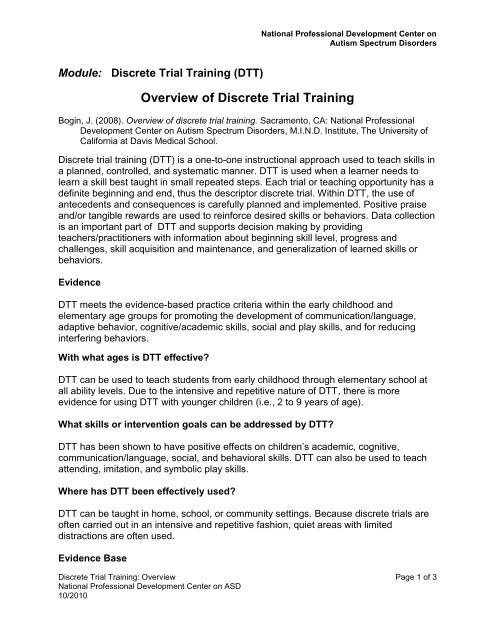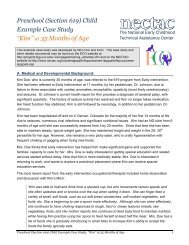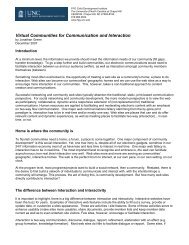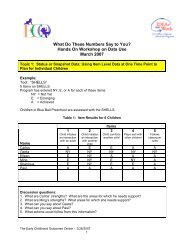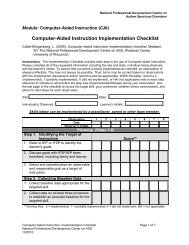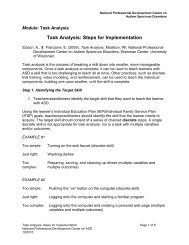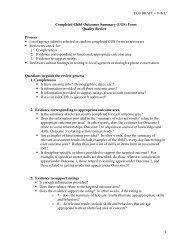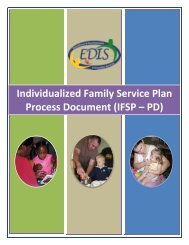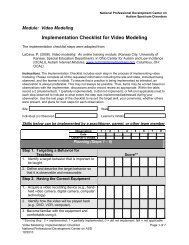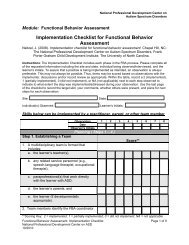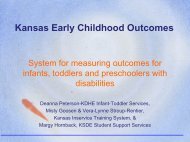Overview of Discrete Trial Training - National Professional ...
Overview of Discrete Trial Training - National Professional ...
Overview of Discrete Trial Training - National Professional ...
Create successful ePaper yourself
Turn your PDF publications into a flip-book with our unique Google optimized e-Paper software.
<strong>National</strong> Pr<strong>of</strong>essional Development Center on<br />
Autism Spectrum Disorders<br />
Module: <strong>Discrete</strong> <strong>Trial</strong> <strong>Training</strong> (DTT)<br />
<strong>Overview</strong> <strong>of</strong> <strong>Discrete</strong> <strong>Trial</strong> <strong>Training</strong><br />
Bogin, J. (2008). <strong>Overview</strong> <strong>of</strong> discrete trial training. Sacramento, CA: <strong>National</strong> Pr<strong>of</strong>essional<br />
Development Center on Autism Spectrum Disorders, M.I.N.D. Institute, The University <strong>of</strong><br />
California at Davis Medical School.<br />
<strong>Discrete</strong> trial training (DTT) is a one-to-one instructional approach used to teach skills in<br />
a planned, controlled, and systematic manner. DTT is used when a learner needs to<br />
learn a skill best taught in small repeated steps. Each trial or teaching opportunity has a<br />
definite beginning and end, thus the descriptor discrete trial. Within DTT, the use <strong>of</strong><br />
antecedents and consequences is carefully planned and implemented. Positive praise<br />
and/or tangible rewards are used to reinforce desired skills or behaviors. Data collection<br />
is an important part <strong>of</strong> DTT and supports decision making by providing<br />
teachers/practitioners with information about beginning skill level, progress and<br />
challenges, skill acquisition and maintenance, and generalization <strong>of</strong> learned skills or<br />
behaviors.<br />
Evidence<br />
DTT meets the evidence-based practice criteria within the early childhood and<br />
elementary age groups for promoting the development <strong>of</strong> communication/language,<br />
adaptive behavior, cognitive/academic skills, social and play skills, and for reducing<br />
interfering behaviors.<br />
With what ages is DTT effective<br />
DTT can be used to teach students from early childhood through elementary school at<br />
all ability levels. Due to the intensive and repetitive nature <strong>of</strong> DTT, there is more<br />
evidence for using DTT with younger children (i.e., 2 to 9 years <strong>of</strong> age).<br />
What skills or intervention goals can be addressed by DTT<br />
DTT has been shown to have positive effects on children’s academic, cognitive,<br />
communication/language, social, and behavioral skills. DTT can also be used to teach<br />
attending, imitation, and symbolic play skills.<br />
Where has DTT been effectively used<br />
DTT can be taught in home, school, or community settings. Because discrete trials are<br />
<strong>of</strong>ten carried out in an intensive and repetitive fashion, quiet areas with limited<br />
distractions are <strong>of</strong>ten used.<br />
Evidence Base<br />
<strong>Discrete</strong> <strong>Trial</strong> <strong>Training</strong>: <strong>Overview</strong> Page 1 <strong>of</strong> 3<br />
<strong>National</strong> Pr<strong>of</strong>essional Development Center on ASD<br />
10/2010
<strong>National</strong> Pr<strong>of</strong>essional Development Center on<br />
Autism Spectrum Disorders<br />
Module: <strong>Discrete</strong> <strong>Trial</strong> <strong>Training</strong> (DTT)<br />
The studies cited in this section document that this practice meets the NPDC on ASD’s<br />
criteria for an evidence-based practice. This list is not exhaustive; other quality studies<br />
may exist that were not included.<br />
Preschool<br />
Cohen, H., Amerine-Dickens, M., & Smith, T. (2006). Early intensive behavioral<br />
treatment: Replication <strong>of</strong> the UCLA model in a community setting. Journal <strong>of</strong><br />
Developmental and Behavioral Pediatrics, 27(2), 145-155.<br />
Howard, J. S., Sparkman, C. R., Cohen, H. G., Green, G., & Stanislaw, H. (2005). A<br />
comparison <strong>of</strong> intensive behavior analytic and eclectic treatments for young<br />
children with autism. Research in Developmental Disabilities, 26(4), 359-383.<br />
Remington, B., Hastings, R.P., Kovsh<strong>of</strong>f, H., Degli Espinosa, F., Jahr, E., Brown T., et<br />
al. (2007). Early intensive behavioral intervention: Outcomes for children with<br />
autism and their parents after two years. American Journal on Mental<br />
Retardation, 112(6), 418-438.<br />
Smith, T., Groen, A., & Wynn, J. W. (2000). Randomized trial <strong>of</strong> intensive early<br />
intervention for children with pervasive developmental disorder. American<br />
Journal on Mental Retardation, 105(4), 269-285.<br />
Whalen, C., & Schreibman, L. (2003). Joint attention training for children with autism<br />
using behavior modification procedures. Journal <strong>of</strong> Child Psychology &<br />
Psychiatry, 44(3), 456-468.<br />
Elementary<br />
Dib, N., & Sturmey, P. (2007). Reducing student stereotypy by improving teachers'<br />
implementation <strong>of</strong> discrete-trial teaching. Journal <strong>of</strong> Applied Behavior Analysis,<br />
40(2), 339-343.<br />
Eikeseth, S., Smith, T., Jahr, E., & Eldevik, S. (2002). Intensive behavioral treatment at<br />
school for 4-7 year-old children with autism. Behavior Modification. 26(1), 49-68.<br />
Lovaas, O. I. (1987). Behavioral treatment and normal educational and intellectual<br />
functioning in young autistic children. Journal <strong>of</strong> Consulting and Clinical<br />
Psychology. 55, 3-9.<br />
<strong>Discrete</strong> <strong>Trial</strong> <strong>Training</strong>: <strong>Overview</strong> Page 2 <strong>of</strong> 3<br />
<strong>National</strong> Pr<strong>of</strong>essional Development Center on ASD<br />
10/2010
<strong>National</strong> Pr<strong>of</strong>essional Development Center on<br />
Autism Spectrum Disorders<br />
Module: <strong>Discrete</strong> <strong>Trial</strong> <strong>Training</strong> (DTT)<br />
McEachin, J. J., Smith, T., & Lovaas, O. I. (1993). Long-term outcomes for children with<br />
autism who received early intensive behavioral treatment. American Journal on<br />
Mental Retardation, 97(4), 359-372.<br />
Selected Additional References<br />
Eikeseth, S., Smith, T., Jahr, E., & Eldevik, S. (2007). Outcomes for children with autism<br />
who began intensive behavioral treatment between ages 4 and 7: A comparison<br />
controlled study. Behavior Modification, 31(3), 264-278.<br />
Leaf, R., & McEachin J. (1999). A work in progress. New York, NY: Autism Partnership<br />
Lovaas, O. I., & Smith, T. (1989). A comprehensive behavioral theory <strong>of</strong> autistic<br />
children: Paradigm for research and treatment. Journal <strong>of</strong> Behavior Therapy and<br />
Experimental Psychiatry, 20, 17-29<br />
Lovaas, O. I., Schreibman, L., Koegel, R., & Rehm, R. (1971). Selective responding by<br />
autistic children to multiple sensory input. Journal <strong>of</strong> Abnormal Psychology,<br />
77(3), 211-222.<br />
Lovaas, O. I., Ackerman, A. B., Alexander, D., Firestone, P., Perkins, J., & Young, D.<br />
(1981). Teaching developmentally disabled children: The ME book. Austin, TX:<br />
Pro-Ed.<br />
Lovaas, O. I., Koegel, R., Simmons, J., & Long, J.S. (1973). Some generalization and<br />
follow-up measures on autistic children in behavior therapy. Journal <strong>of</strong> Applied<br />
Behavior Analysis. 6(1), 131-166.<br />
Lovaas, O I., Schreibman, L., & Koegel, R. (1974). A behavior modification approach to<br />
the treatment <strong>of</strong> autistic children. Journal <strong>of</strong> Autism and Childhood<br />
Schizophrenia, 4(2), 111-129.<br />
Matson, J., Benavidez, D., Compton, L. S., Paclawskyj, T., & Baglio, C. (1996).<br />
Behavioral treatment <strong>of</strong> autistic persons: A review <strong>of</strong> research from 1980 to the<br />
present. Research in Developmental Disabilities, 17(6), 433-465.<br />
Maurice, C. (1993). Let me hear your voice. NY: Knopf.<br />
Smith, T. (1999). Outcome <strong>of</strong> early intervention for children with autism. Clinical<br />
Psychology: Science and Practice, 6(1), 33-49.<br />
Taylor, B. A., & McDonough, K. A. (1996). Selecting teaching programs. In C. Maurice,<br />
G. Green, & S. C. Luce (Eds.). Behavioral intervention for young children with<br />
autism: A manual for parents and pr<strong>of</strong>essionals (pp. 63-177). Autism, TX: Pro Ed.<br />
<strong>Discrete</strong> <strong>Trial</strong> <strong>Training</strong>: <strong>Overview</strong> Page 3 <strong>of</strong> 3<br />
<strong>National</strong> Pr<strong>of</strong>essional Development Center on ASD<br />
10/2010


